Manila Light Rail Transit System Line 1
The Manila Light Rail Transit System Line 1 is the first metro line of the Manila Light Rail Transit System. Presently, the line contains twenty stations and runs on 19.65 kilometers (12.21 mi)[7] of fully elevated route. The line is colored yellow (old) and green (new) on all LRT maps.
The line runs in a general north-south direction from Baclaran to Monumento; then, it runs in an east-west direction from Monumento to North Avenue, linking the cities of Quezon City, Caloocan, Manila, Pasay, and Parañaque. Passengers can transfer to the Line 2 at Doroteo Jose station, while passengers can transfer to the Line 3 at EDSA and North Avenue stations.
The Line 1 was known for many names such as LRT Line 1, shortened to LRT-1, Yellow Line, Green Line (2012), or the Metrorail. However, the yellow color of the line dates back to its opening in 1984.
On October 12, 2014, Light Rail Manila Corporation (LRMC), a joint venture company of Metro Pacific's Metro Pacific Light Rail Corporation (MPLRC), Ayala Corporation’s AC Infrastructure Holdings Corporation (AC Infra), and the Philippine Investment Alliance for Infrastructure’s Macquarie Infrastructure Holdings (Philippines) PTE Ltd.(MIHPL), signed a concession agreement with the Department of Transportation (DOTr) and Light Rail Transit Authority (LRTA) for the operation and maintenance of LRT Line 1 and the construction of a PhP 65 billion extension project to Bacoor, Cavite.[8][9] LRMC, in turn, contracted the operation and maintenance of the line for 20 years to RATP Dev under its subsidiary RATP Dev Transdev Asia, a joint venture between Transdev and RATP Dev.[10][11] The 32-year concession started on September 12, 2015.
History
- December 1, 1984: Baclaran to Central Terminal
- May 12, 1985: Carriedo to Monumento
- March 22, 2010: Balintawak
- October 22, 2010: Roosevelt
Technical specifications
- Name: Manila Light Rail Transit System Line 1
- Concession holder: Light Rail Manila Corporation
- Operator: Light Rail Manila Corporation
- Length: 19.65 km + 11.7 km (Cavite Extension)
- Concession starting date: 2015
- Concession ending date: 2047
- Stations: 20 + 8 (Cavite extension)
Route
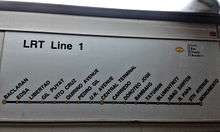
.jpg)
The Line 1 is predominantly aligned to the path of Taft Avenue (Radial Road 2), which was chosen largely due to its straight length. Later on, as Taft Avenue ends, it shifts to Rizal Avenue and Rizal Avenue Extension (Radial Road 9) then turning right at EDSA or Circumferential Road 4 (C-4 Road) before ending at the corner of North and West Avenues and EDSA.
Stations
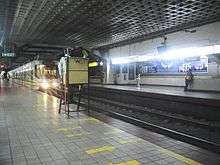
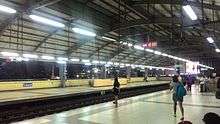
Manila Light Rail Transit System Line 1 serves 20 stations along its route. A twenty-first station is yet to be constructed.[12] Eight stations, which are part of the LRT-1 South Extension Project, are also set to be constructed south of Baclaran.
A previously proposed station, Malvar station in Caloocan, was proposed during the construction of the northern extension, and became a barganing object during its construction, and has since been shelved by the current administration.
| Name | Distance (km) | Transfers | Location | |
|---|---|---|---|---|
| Between stations | From Roosevelt | |||
| North Avenue Common Station |
— | — | MRT-3 MRT-7 Metro Manila Subway |
Quezon City |
| Roosevelt | — | 0.000 | none | |
| Balintawak | 1.870 | 1.870 | ||
| Monumento | 2.250 | 4.120 | Caloocan City | |
| 5th Avenue | 1.087 | 5.207 | ||
| R. Papa | 0.954 | 6.161 | Manila | |
| Abad Santos | 0.660 | 6.821 | ||
| Blumentritt | 0.927 | 7.748 | PNR MSC | |
| Tayuman | 0.671 | 8.419 | none | |
| Bambang | 0.618 | 9.037 | ||
| Doroteo Jose | 0.648 | 9.685 | LRT-2 | |
| Carriedo | 0.685 | 10.370 | none | |
| Central Terminal | 0.725 | 11.095 | ||
| United Nations | 1.214 | 12.309 | ||
| Pedro Gil | 0.754 | 13.063 | ||
| Quirino | 0.794 | 13.857 | ||
| Vito Cruz | 0.827 | 14.684 | ||
| Gil Puyat | 1.061 | 15.745 | Pasay City | |
| Libertad | 0.730 | 16.475 | ||
| EDSA | 1.010 | 17.485 | MRT-3 | |
| Baclaran | 0.588 | 18.073 | none | |
| Redemptorist | — | — | Parañaque City | |
| Manila International Airport | — | — | ||
| Asia World | — | — | ||
| Ninoy Aquino | — | — | ||
| Dr. A. Santos | — | — | ||
| Las Piñas | — | — | Las Piñas City | |
| Zapote | — | — | Bacoor City, Cavite | |
| Niog | — | — | LRT-6 | |
| Stations in italics are either under construction, not yet operational, or have been closed. | ||||
Rolling stock
The LRT Line 1 at various stages in its history has used a two-car, three-car, and four-car trainsets. The two-car trains are the original first-generation BN and ACEC trains (railway cars numbered from 1000). Most were transformed into three-car trains, although some two-car trains remain in service. The four-car trains are the more modern second-generation Hyundai Precision and Adtranz (1100) and third-generation Kinki Sharyo / Nippon Sharyo (1200) trains.[13][14] There are 139 railway cars grouped into 40 trains serving the line: 63 of these are first-generation cars, 28 second-generation, and 48 third-generation. One train car (1037) was severely damaged in the Rizal Day bombings and was subsequently decommissioned.[15][16] The maximum speed of these cars is 80 kilometers per hour (50 mph).[17][18]
The LRT Line 1 fleet is being modernized to cope with increasing numbers of passengers. In the initial phase of its capacity expansion program completed in 1999, the line's seven four-car second-generation trains were commissioned providing an increased train capacity of 1,350 passengers while the original two-car trains capable of holding 748 passengers were transformed into three-car trains with room for 1,122.[13]
The acquisition marked the introduction of the first air-conditioned trains to the line. Earlier LRT Line 1 rolling stock was notorious for its lack of air conditioning, relying instead on forced-air roof ventilation for cooling.[19] Unfortunately, this resulted in hot and stuffy rides. The problem was addressed more fully after a preparatory rehabilitation program completed in 2001 allowed the installation of air conditioners to the older rolling stock.[20] By June 2004, all Yellow Line trains had air conditioning.[21][22]
As part of the second phase of expansion on the Yellow Line, 12 new trains made in Japan by Kinki Sharyo and provided by the Manila Tren Consortium were shipped in the third quarter of 2006 and went into service in the first quarter of 2007. The new air-conditioned trains have boosted the capacity of the line from 27,000 to 40,000 passengers per hour per direction.[14][23][24]
As of recent, the original trainsets are undergoing a body repaint and repair to address body issues and put it at par with its newer trains in terms of aesthetics. However, a majority of the second-generation trains are currently not operational due to various issues such as air-conditioning and propulsion issues, now a subject of an extensive rehabilitation program[25]. 4 of the coaches in the third-generation trains currently out of service is most likely the trainset that figured in the train collision in Roosevelt station.
LRMC has also built an in-house laboratory for production, manufacturing, fabrication and repair of train parts that are no longer available in the market.
A New Rolling Stock is awarded to the Mitsubishi Corporation and manufacturing partner CAF, together with JICA valued at P64.9 billion for 120 cars, or 30 train sets, to the LRT-1, in order to cover it's Cavite Extension, and able to service more passengers. The Train Sets will be delivered from 2020 to 2022. [26] [27]
| Rolling stock | First-generation | Second-generation | Third-generation |
|---|---|---|---|
| Image | 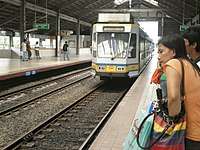 |
 |
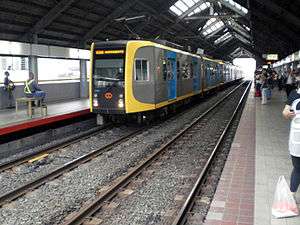 |
| Year | 1984 | 1999 | 2007 |
| Manufacturer | BN Constructions Ferroviaires et Métalliques / SA Ateliers de Constructions Electriques de Charleroi | Hyundai Precision / Adtranz | Kinki Sharyo / Nippon Sharyo |
| Model | 1000 series | 1100 series | 1200 series |
| Number Built (cars) | 64 built; 41 in service 15 out of service 8 decommissioned | 28 built; 12 in service 16 out of service | 48 built; 44 in service 4 out of service |
| Car type | 8-axle (4 bogie) rigid body | 6-axle (3 bogie) rigid body | |
| Length | 29280 mm | 26500 mm (MC car w/ coupler) 26350 mm (M Car w/anti-climber/semi permanent coupler) | |
| Width | 2500 mm | 2590 mm | |
| Height(From top of rail) | 3525 mm | 3740 mm | 3910 mm |
| Configuration | MC-MC 59590 mm (2-car) 89370 mm MC-MC-MC (3-car) |
MC-M-M-MC 105700 mm (4 car) MC-M-MC 79350 mm (3 car) MC-MC 53000 mm (2 car) | |
| Articulation | Double | Single | |
| Capacity | 748-1,122 passengers (81 seated, 293 standing) | 1,358 passengers (320 seated 1038 standing) | 1,388 passengers (272 seated 1116 standing @ 7 passengers m^2) |
| Doors | 1400 mm wide; Plug-type; 5-doors/side | 1500 mm wide x 1900 mm high ; Interior sliding type; 4-doors/side | |
| Traction system | DC 218 Kw Chopper Type x 1 | AC 125 kW VVVF Type with regeneration x 2 | AC 105 kW VVVF Control with regeneration x 2 |
| Traction power | 750 V DC OCS; pantograph power connection | ||
| Body Material | BI sheet | Stainless steel | |
| Ventilation | Forced ventilation (pre–2003 refurbishment); 12 units/car Air-conditioned; roof-mounted duct type; 5 units/car (refurbished) Air-conditioned & Forced ventilation Dome Air Vent PowerCool BR26; roof-mounted duct type; 5 (BR26) & 4 (Kolin/Sidwal) units/car (refurbished) | Air-conditioned; roof-mounted duct type; 2 units/car | |
| Status | In service; rehabilitated in 2003–2004 and 2016–present | In Service | |
Plans
South Extension Phase 1 (LRT-1 Extension)
A south extension of Line 1, also known as the South Extension Project or the Cavite Extension Project in the Metro Manila Rail Plans has been proposed and would aim to serve the areas of Parañaque to Cavite. Such an extension would take Quirino Avenue (Road from Parañaque to Bacoor) then would travel on the side of Seaside Drive to the Coastal Road, and from there would travel down the side of Kabihasnan street to Quirino Avenue (again) to its extension, General Emilio Aguinaldo Avenue from the Las Pinas-Bacoor Boundary of Zapote Bridge to Niog. The extension would add 8 stations over some 11.7 kilometers (7.3 mi) of new line and would be the second rail line extending outside the Metro Manila area (after the under construction MRT Line 7).
An unsolicited bid to conduct this work from Canada's SNC-Lavalin was rejected by the Philippine government in 2005. In 2006, the government worked with advisers (International Finance Corporation, White & Case, Halcrow and others) to conduct an open-market invitation to tender for the extension and for a 30-year concession to run the extended LRT-1 line. President Gloria Macapagal Arroyo subsequently withdrew the project.
The South Extension Project will be done in phases: Phase 1 will start from Dr. A. Santos Avenue towards Redemptorist Road in Baclaran. Phase 2 will start from Dr. A. Santos Avenue towards Niog. The LRT-1 South Extension Project will consist of the following eight stations:
- Redemptorist Station – Parañaque
- Manila International Airport Station – Parañaque
- Asia World Station – Parañaque
- Ninoy Aquino Station – Parañaque
- Dr. A. Santos Station – Parañaque
- Las Piñas Station – Las Piñas
- Zapote Station – along the boundaries of Bacoor and Las Piñas
- Niog Station – Bacoor
On May 4, 2017, the groundbreaking for the South Extension Project was held.[29] DOTr secretary Arthur Tugade projected the early completion of the project to be by 2020.[30][31]
The line would be extended from Parañaque southwards, connecting Las Piñas and Bacoor to the LRT network. The actual construction will start by first quarter of 2019 once the Right-of-way issues are substantially addressed. The extension From Baclaran to Dr. A. Santos Avenue is expected to be operational by third quarter of 2021. The extension will reach Bacoor in Cavite and is expected to be finished by 2023.
South Extension Phase 2 (LRT-6)
Another extension of the LRT-1 in Cavite has been proposed. It will be extended by another 19 kilometres (12 mi) from Bacoor to Dasmariñas with a right-of-way alignment along Aguinaldo Highway. This public-private partnership project dubbed as LRT-6 would have 6 additional stations in Cavite.
The 6 stations of the proposed South Extension Phase 2 are composed of:
- Tirona Station – Bacoor
- Imus Station – Imus
- Daang Hari Station – Imus
- Salitran Station – Dasmariñas
- Congressional Avenue Station – Dasmariñas
- Governor's Drive Station – Dasmariñas
Incidents and accidents
Terrorism
Rizal Day bombings
On Rizal Day in the year 2000, a Yellow Line train (Car number 1037) exploded near Blumentritt station as part of a series of explosions in a terrorist attack known as the Rizal Day bombings. The attack on the LRT killed some 22 people and injured hundreds. Eight members of both Jemaah Islamiyah and the Moro Islamic Liberation Front (MILF), which include Hambal, Asia's most wanted man, and Fathur Rahman al-Ghozi, were charged with plotting and masterminding the attacks in 2003, some three years after the attacks. Three suspects were put on trial,[32][33] with al-Ghozi receiving 17 years in prison due to the illegal possession of explosives. Al-Ghozi later died in a firefight after attempting to escape from prison. Car number 1037 is currently decommissioned, but there are plans to reconstruct it.
Suicides and births
LRT Line 1 also witnessed several cases of suicides and suicide attempts, including one case involving a fisherman, who soon died, a 41-year-old woman, who survived, and a man, who jumped from the 26th floor of a condominium building and was subsequently crushed by a southbound LRT train.[34][35][36][37] The line also witnessed births involving women who were heading towards hospitals accessible through the LRT, and the first case recorded occurred on May 5, 2005, involving a woman named Lea Aquino Ababa, from Pasay.[38][39]
Fires
Fires, mostly occurring near the line, also caused service disruptions on the LRT Line 1 on several instances.
- Train operations from Central Terminal to Baclaran were temporarily suspended after a fire in a residential area in Pasay City forced the suspension of operations due to the proximity of one of the burning buildings to Libertad station. Operations from Central Terminal to Monumento still operated as scheduled. Full service was restored after the fire was controlled.[40]
- Train operations to and from Baclaran were suspended because of a fire at the Baclaran Galleria shopping mall that started at around 5:00 am. Until noontime the fire was still spreading to nearby establishments, and flames even started to encroach entrance of the station. Earlier the station had to be closed because of the thick smoke coming from the fire.[41]
- Train operations were limited from Monumento to Gil Puyat when fire broke out in a 4-story Puregold commercial building beside Libertad station at around 2:00 am. Normal operations resumed in the afternoon after the fire was controlled.[42]
Train Malfunctions
Unlike the MRT-3 that has been virtually crippled due to poor maintenance, the LRT-1 has seldom train malfunctions and has been mostly functional; however, occasional malfunctions such as line glitches limiting station travels, train malfunctions such as train doors being open while running, 'code yellow' and 'code red', cases where whole trainsets bog down in the middle of a revenue run have been reported sporadically.
See also
References
- ↑ "About Us – MRT3 Stations". Metro Rail Transit. Archived from the original on January 22, 2013. Retrieved June 8, 2014.
- ↑ "About Us – Background". Metro Rail Transit. Archived from the original on May 8, 2014. Retrieved June 8, 2014.
- ↑ "Key Performance Indicator – Line 1 – Green Line". Light Rail Transit Authority. Archived from the original on 2014-10-16. Retrieved 2014-06-09.
- ↑ http://cityrailtransit.com/timeline/manila_timeline.htm
- ↑ "About Us – MRT3 Trains". Metro Rail Transit. Archived from the original on May 8, 2014. Retrieved June 8, 2014.
- ↑ "manila lrt – line lrt1" (PDF). Systra. Systra. Retrieved 25 July 2016.
- ↑ "The LRT Line 1 System". Light Rail Transit Authority. Archived from the original on 2014-07-14. Retrieved 2014-06-09.
- ↑ "P65B Manila-Cavite Transit Project Underway". Social Patrol. Retrieved May 8, 2017.
- ↑ "Company profile". Light Rail Manila Corporation. Retrieved 4 February 2018.
- ↑ {{https://ph.ambafrance.org/Light-Rail-Manila-Corp-inks%7Ctitle=Light Rail Manila Corp inks operation and maintenance contract with French firm RATP Dev for the LRT1 extension project|publisher=France in the Philippines and in Micronesia - Embassy of France in Manila|accessdate=4 February 2018|
- ↑ "Philippines: Manila LRT-1 Cavite Extension" (PDF). International Finance Corporation. Retrieved 4 February 2018.
- ↑ "LRT Line 1 and LRT Line 2 Route Map". Light Rail Transit Authority. Archived from the original on 2014-05-28. Retrieved 2014-06-10.
- 1 2 3 The LRT Line 1 Capacity Expansion Project (Phase I) Archived 2006-05-17 at the Wayback Machine.. [ca. 2003]. Light Rail Transit Authority. Retrieved April 7, 2006.
- 1 2 Kinki Sharyo. [ca. 2010]. Light Rail Transit Authority, Manila Philippines, Light Rail Vehicle. Retrieved March 8, 2010 from the Kinki Sharyo Website.
- ↑ "Light Rail Transit Authority Annual Report 2006" (PDF). Light Rail Transit Authority. Planning Department/MIS Division. 2007. pp. 18–20. Archived from the original (pdf) on July 8, 2008. Retrieved January 15, 2010.
- ↑ "List of the entire fleet of light rail vehicles of LRT-1 and trainsets of LRT-2 with other details". eFreedom of Information. Government of the Philippines. Retrieved 27 February 2017.
- ↑ Razon, Evangeline M. (June 1998). "The Manila LRT System" (pdf). Japan Railway and Transport Review. 16: 38–39. Retrieved December 15, 2009.
- ↑ Otaki, Tsutomu (2007). "The Commissioning – In Case of a Project in Manila" (pdf). KS World. Kinki Sharyo. 14: 12–13. Retrieved January 15, 2010.
- ↑ Ronda, Rainier Allan. (August 15, 2003). "No More 'Sweaty' LRT Rides". The Philippine Star. Retrieved January 23, 2010.
- ↑ The LRT Line 1 Rehabilitation I Project Phase 3 – Rolling Stock Rehabilitation Archived 2013-05-22 at the Wayback Machine.. [ca. 2010]. Light Rail Transit Authority. Retrieved January 19, 2010.
- ↑ Varella, Benjie. (September 26, 2003). "LRT to have all air-conditioned trains by April". The Manila Times. Archived from the original on April 15, 2005. Retrieved April 7, 2006.
- 1 2 "LRT Line 1 Capacity Expansion Project (Phase II): Package B". Light Rail Transit Authority. Archived from the original on 2013-05-22. Retrieved 2014-06-11. Retrieved April 7, 2006 from the LRTA Website.
- ↑ "3rd Generation LRV Mock Up on Display". Light Rail Transit Authority. March 9, 2006. Archived from the original on April 24, 2006. Retrieved April 7, 2006.
- ↑ Olchondra, Riza T. (December 7, 2006). "'3G' trains to serve LRTA riders Dec. 11: More comfortable, safer rides assured for commuter Archived 2013-02-22 at Archive.is". Philippine Daily Inquirer. Retrieved February 7, 2010.
- ↑ http://business.inquirer.net/246361/lrmc-signs-p450-m-deal-train-rehab-upgrade
- ↑ https://business.inquirer.net/241116/lrt-1-get-new-train-cars-japans-mitsubishi
- ↑ https://www.metro-report.com/news/single-view/view/caf-awarded-manila-rolling-stock-contract.html
- ↑ http://ppp.gov.ph/wp-content/uploads/2012/05/LRT1_CavExt_PIM_04Jun2012.pdf
- ↑ "DESPITE DELAYS: Tugade says LRT1 Cavite extension to be completed in 2021". GMA News Online. Retrieved 2018-07-08.
- ↑ Barrow, Keith (May 4, 2017). "Manila breaks ground on LRT 1 Cavite extension". International Railway Journal. Simmons-Boardman Publishing. Retrieved May 4, 2017.
- ↑ Cordero, John Ted (May 4, 2017). "DOTr, LRMC break ground for LRT-1 Cavite extension project". GMA News Online. Retrieved May 5, 2017.
- ↑ Terrorist raps filed vs Asia's most wanted man, Philippine Daily Inquirer, July 8, 2003
- ↑ DOJ Indicts Asia's Most Wanted Terrorist in 2000 LRT Bombing, Department of Justice Press Release, July 7, 2003
- ↑ Seaman killed by LRT train, Philippine Star, May 26, 2005
- ↑ Woman jumps into LRT tracks, survives Archived 2009-03-29 at the Wayback Machine., Philippine Daily Inquirer, March 26, 2009
- ↑ Cops tag man who committed suicide at LRT, ABS-CBN Interactive, April 5, 2007
- ↑ Man jumps onto LRT tracks, Philippine Star, August 18, 2005
- ↑ Childbirth at Doroteo Jose Station Archived 2008-07-08 at the Wayback Machine., Light Rail Transit Authority Press Release, December 1, 2005
- ↑ Woman gives birth inside a LRT-1 coach, ABS-CBN News and Current Affairs, October 30, 2010
- ↑ Fire partially stops LRT operations Archived 2009-06-28 at the Wayback Machine., Philippine Daily Inquirer, December 18, 2007
- ↑ Baclaran blaze continues to spread, officials raise fire alarm level, GMA News and Public Affairs, January 3, 2008
- ↑ Fire disrupts operations at LRT Libertad station, GMA News and Public Affairs, July 17, 2008